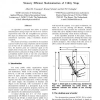Free Online Productivity Tools
i2Speak
i2Symbol
i2OCR
iTex2Img
iWeb2Print
iWeb2Shot
i2Type
iPdf2Split
iPdf2Merge
i2Bopomofo
i2Arabic
i2Style
i2Image
i2PDF
iLatex2Rtf
Sci2ools
101
click to vote
ICDAR
1997
IEEE
1997
IEEE
Memory efficient skeletonization of utility maps
An algorithm is presented that allows to perform skeletonization of large maps with much lower memory requirements than with the straightforward approach. The maps are divided into overlapping tiles, which are skeletonized separately, using a Euclidean distance transform. The amount of overlap is controlled by the maximum expected width of any map component and the maximum size of what will be considered as a small component. Next, the skeleton parts are connected again at the middle of the overlap zones. Some examples are given for efficient memory utilization in tiling an A0 size map into a predefined number of tiles or into tiles of predefined (square) size. The algorithm is also suited for a parallel implementation of skeletonization.
Document Analysis | Euclidean Distance Transform | ICDAR 1997 | Lower Memory Requirements | Maximum Expected Width |
Related Content
| Added | 06 Aug 2010 |
| Updated | 06 Aug 2010 |
| Type | Conference |
| Year | 1997 |
| Where | ICDAR |
| Authors | Albert M. Vossepoel, Klamer Schutte, Carl F. P. Delanghe |
Comments (0)

